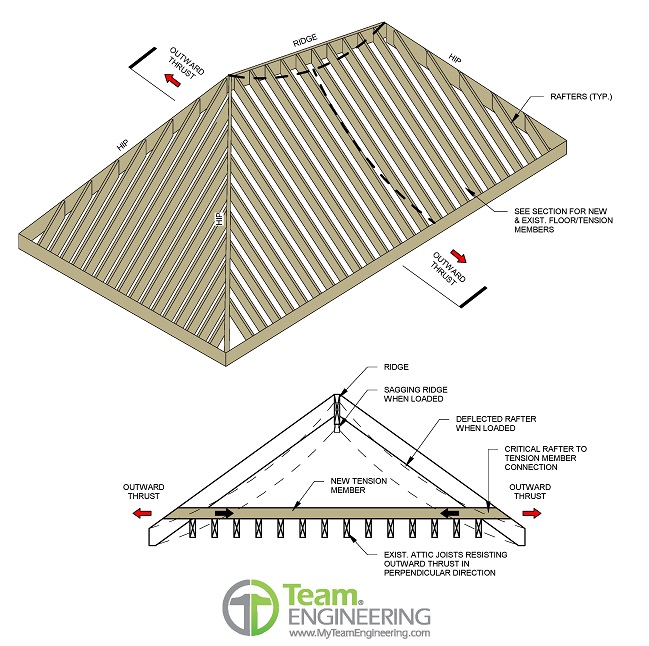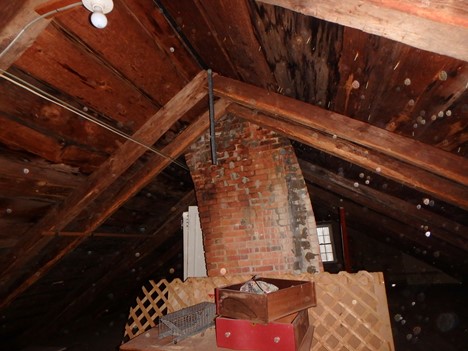
Repair of Antique Hip Roof
By Nancy Nichols, P.E.
 Antique hip roofs tend to have a short sagging ridge. They get flatter over time. The attic insulation, if present, has a low R-value. There are frequently broken rafters. How do we make our old homes warmer and safer without stripping off the entire roof, frame and all?
Antique hip roofs tend to have a short sagging ridge. They get flatter over time. The attic insulation, if present, has a low R-value. There are frequently broken rafters. How do we make our old homes warmer and safer without stripping off the entire roof, frame and all?
The ridges sag due to historical snow accumulations and lateral thrust. When the snow accumulates on the roof, the tails of opposing rafters are forced outwards (i.e., lateral thrust). In a modern gable roof, the floor joists and rafters created a triangle that is stable because the floor joists resist this outward force. However, in an antique hip roof, the attic floor joists, if they are present, are oriented/attached to rafters in one direction (e.g., front-to-back), but the snow is pushing out the rafter tails in both directions (front-to-back and side-to-side) so the walls are also pushed outwards and the ridge sags.
The modern solution to outward thrust of a hip roof is to install ridge poles. This works great but requires the poles be supported by columns to footings, or beams to columns to footings. This is a whole-house project, and more economically incorporated into a new house design than as a retrofit to an old house. Another somewhat effective but less invasive and costly solution is the installation of a continuous attic floor that is glued and nailed to act as a structural diaphragm to which the tails of all rafters are fastened. Other solutions are possible, depending on the house layout and condition.

Antique hip roofs are also undersized (i.e., rafters and hips are overspanned) for modern insulation and snow levels. Many antique hip roofs were constructed for use without roof insulation so the snow rapidly melted by heat loss through the roof. Attic ventilation usually is also insufficient or non-existent causing the framing to often be damp, moldy and/or rotted. Framing reinforcements and/or replacements may be needed for rotted or damaged wood.
If there are no obstructions (e.g., chimneys), resurfacing the roof with metal roofing can help reduce lateral thrust as well as vertical snow loading because the snow slides off the roof more readily than for a shingle roof. On the other hand, adding insulation will increase snow loads. So, there is obviously a balance of loads and functionality that needs to be struck.
There are tough decisions to make about how to repair an Antique Hip Roof. We can help you with these by conferring on a repair concept or preparing repair plans. Let’s work together to make your home warmer, safer and healthier.
More Articles From...
| This Category | Engineered Consultations, Home Repairs, Residential Engineering, Structural Design, Structural Engineering |
| This Author | Nancy Nichols, P.E. |
